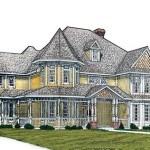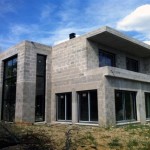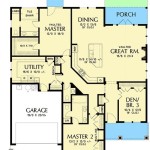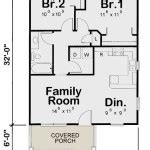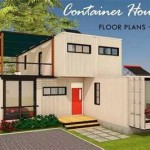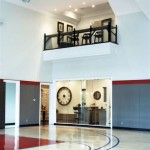Attached Garage House Plans refer to architectural blueprints that outline the design and construction of a house with an attached garage. The garage is directly connected to the house, typically through an interior door, providing convenience and protection for vehicles, storage, and other activities.
Attached garages offer several advantages. They provide a secure and covered space for parking vehicles, safeguarding them from the elements and potential theft. Additionally, the direct connection to the house allows for easy access to the garage from the living area, reducing the hassle of going outside to retrieve items or work on vehicles.
As we delve into this article, we will explore the key considerations, benefits, and design aspects of Attached Garage House Plans, guiding you towards informed decision-making when planning your dream home.
When considering Attached Garage House Plans, several important points merit attention:
- Garage Size and Layout
- Interior Connection
- Materials and Finishes
- Energy Efficiency
- Safety Features
- Roof Design
- Curb Appeal
- Cost Implications
These factors influence the functionality, aesthetics, and overall value of your attached garage, ensuring alignment with your needs and preferences.
Garage Size and Layout
Determining the appropriate size and layout for your attached garage is crucial to ensure it meets your functional requirements and complements the overall design of your home.
- Vehicle Capacity: Consider the number of vehicles you need to accommodate. A standard single-car garage typically measures around 12 feet wide by 20 feet deep, while a two-car garage is typically 20 feet wide by 20 feet deep. If you have larger vehicles or need additional storage space, you may opt for a wider or deeper garage.
- Storage Needs: Beyond vehicles, determine what other items you need to store in the garage, such as tools, equipment, seasonal items, or recreational gear. Allocate sufficient space for shelving, cabinets, or a workbench if necessary.
- Interior Arrangement: Plan the placement of your vehicles and storage areas to optimize functionality. Consider the location of the garage door, windows, and interior door connecting to the house. Ensure there is ample room to maneuver vehicles and access stored items conveniently.
- Ceiling Height: Standard garage ceilings are typically 8 feet high, but you may want to consider a higher ceiling if you plan to use a lift or store taller items. Adequate ceiling height also improves ventilation and natural light.
Optimizing garage size and layout not only enhances practicality but also contributes to the overall aesthetic appeal and value of your home.
Interior Connection
The interior connection between the attached garage and the house is a critical aspect that influences convenience, accessibility, and overall functionality.
- Direct Access: An interior door provides direct access from the garage to the house, eliminating the need to go outside to enter the living area. This is particularly beneficial during inclement weather or when carrying groceries or other items.
- Convenience and Comfort: The interior connection enhances convenience by allowing quick and easy access to the garage for various purposes, such as bringing in groceries, storing items, or working on projects. It also provides a comfortable and protected passageway, especially during extreme temperatures or weather conditions.
- Safety and Security: The direct connection between the garage and the house improves safety and security. It reduces the risk of intruders entering the house through the garage, as they would need to breach two entry points instead of one. Additionally, it provides a safe and controlled environment for children and pets to enter and exit the house.
- Energy Efficiency: An insulated and sealed interior connection helps maintain the desired temperature in both the garage and the house. It prevents warm air from escaping during winter and cool air from entering during summer, reducing energy consumption and utility costs.
Properly planning the interior connection between the attached garage and the house ensures a seamless and functional transition between these spaces, enhancing the overall livability and value of your home.
Materials and Finishes
The choice of materials and finishes for your attached garage not only impacts its aesthetics but also its durability, functionality, and energy efficiency.
- Garage Door: The garage door is a prominent feature that affects both the curb appeal and functionality of your garage. Consider factors such as insulation value, security features, and material options like steel, fiberglass, or wood.
- Siding and Trim: The siding and trim of your garage should complement the overall architectural style of your home. Choose materials that are weather-resistant and durable, such as vinyl, fiber cement, or natural wood. Proper sealing and trim details ensure weathertightness and prevent moisture penetration.
- Flooring: The garage floor endures heavy use and potential exposure to moisture and chemicals. Opt for durable and easy-to-clean flooring options such as epoxy coatings, concrete sealers, or interlocking tiles. Consider slip-resistant surfaces for added safety.
- Lighting and Ventilation: Adequate lighting is essential for visibility and safety within the garage. Natural light can be maximized with windows or skylights. Ventilation is crucial to prevent moisture buildup and ensure proper air circulation. Install exhaust fans or passive ventilation systems to maintain a healthy indoor environment.
Selecting the appropriate materials and finishes for your attached garage ensures its longevity, functionality, and aesthetic integration with your home’s overall design.
Energy Efficiency
Attached garages can contribute significantly to a home’s energy consumption, so incorporating energy-efficient measures into their design is crucial. Here are key considerations:
Insulation: Insulating the garage walls, ceiling, and garage door helps maintain desired temperatures within the garage and the house. Proper insulation prevents heat loss during winter and heat gain during summer, reducing the demand on heating and cooling systems.
Air Sealing: Air sealing involves minimizing air leakage around the garage door, windows, and other openings. Gaps and cracks allow conditioned air to escape and unconditioned air to enter, increasing energy consumption. Sealing these gaps with weatherstripping, caulk, and expanding foam ensures a tighter building envelope.
Energy-Efficient Lighting: Utilizing energy-efficient lighting fixtures, such as LED or fluorescent lights, reduces energy consumption and lowers lighting costs. Motion sensors or timers can further enhance efficiency by automatically turning lights off when not in use.
Ventilation: Proper ventilation is essential to prevent moisture buildup and ensure good air quality within the garage. Natural ventilation through windows or vents can help reduce the need for mechanical ventilation systems. Additionally, exhaust fans can be installed to remove fumes and pollutants from the garage.
By incorporating these energy-efficient measures into your Attached Garage House Plans, you can minimize energy consumption, lower utility costs, and contribute to a more sustainable and comfortable living environment.
Safety Features
Attached garages offer several safety features that enhance the security and well-being of occupants:
1. Secure Garage Door: A sturdy and well-insulated garage door acts as a primary barrier against intruders. Choose a door with a strong construction, reinforced panels, and a reliable locking mechanism. Additionally, consider installing a garage door opener with rolling code technology to prevent unauthorized access.
2. Motion-Activated Lighting: Equipping the garage with motion-activated lights deters intruders and improves visibility during nighttime use. These lights automatically turn on when movement is detected, illuminating the garage and its surroundings. This feature enhances safety and security, especially when entering or exiting the garage in low-light conditions.
3. Smoke and Carbon Monoxide Detectors: Installing smoke and carbon monoxide detectors within the garage is crucial for early detection of potential hazards. These devices alert occupants to the presence of smoke or carbon monoxide, allowing them to take prompt action and evacuate if necessary. Regular maintenance and testing of these detectors ensure their proper functioning.
4. Emergency Exit: In the event of an emergency, having a secondary exit from the garage is essential. This could be a door leading directly to the backyard or an escape window that provides an alternative way out. Clearly mark and ensure easy accessibility to this emergency exit for quick evacuation during unforeseen circumstances.
Incorporating these safety features into Attached Garage House Plans not only enhances security but also promotes the well-being and peace of mind of occupants.
Roof Design
The roof design of an attached garage plays a vital role in its overall aesthetics, functionality, and structural integrity. Here are key considerations for roof design in Attached Garage House Plans:
1. Roof Pitch: The roof pitch, or slope, determines the angle at which the roof rises from the walls. A steeper pitch allows for better water drainage and snow shedding, preventing accumulation and potential damage. It is important to consider the local climate and precipitation patterns when determining the optimal roof pitch.
2. Roofing Materials: The choice of roofing materials impacts both the durability and visual appeal of the garage. Asphalt shingles are a popular and cost-effective option, offering a wide range of colors and styles. Metal roofing is known for its longevity and resistance to fire and pests, but it can be more expensive. Other options include tile, slate, and wood shakes.
3. Structural Support: The roof structure must be strong enough to support the weight of the roofing materials, as well as any snow or wind loads it may encounter. Trusses or rafters provide the primary structural support for the roof, and their spacing and dimensions should be carefully calculated to ensure adequate strength and stability.
4. Ventilation: Proper ventilation is crucial to prevent moisture buildup and extend the lifespan of the roof. Ridge vents or soffit vents allow air to circulate and remove moisture that can cause rot and damage to the roofing materials.
Careful consideration of these roof design elements ensures a durable, functional, and aesthetically pleasing attached garage that complements the overall design of your home.
Curb Appeal
Curb appeal refers to the attractiveness and desirability of a property from the street view. An attached garage can significantly impact the curb appeal of your home, and careful consideration should be given to its design and integration with the overall architectural style.
1. Proportion and Balance: The size and placement of the attached garage should complement the proportions of the house. A disproportionately large or small garage can disrupt the visual balance and overall harmony of the facade. Ensure the garage’s height, width, and depth are in harmony with the rest of the house, creating a cohesive and aesthetically pleasing appearance.
2. Architectural Style: The architectural style of the garage should align with the style of the house. For example, a traditional home with gabled roofs and decorative trim would benefit from a garage with a similar design aesthetic. Conversely, a modern home with clean lines and geometric shapes would be well-suited to a garage with a contemporary design.
3. Landscaping and Hardscaping: Landscaping and hardscaping elements around the garage can enhance its curb appeal. Planting trees, shrubs, and flowers can soften the appearance of the garage and create a more inviting atmosphere. Walkways, driveways, and patios made from materials such as brick, stone, or concrete can complement the garage’s design and improve the overall aesthetic of the property.
4. Exterior Finishes: The exterior finishes of the garage, including siding, trim, and paint colors, should complement the finishes of the house. Matching or coordinating the materials and colors creates a cohesive and unified look. Consider using high-quality materials that are durable and resistant to weathering to maintain the garage’s appearance over time.
By paying attention to these curb appeal factors, you can ensure that your attached garage not only provides functionality but also enhances the overall aesthetic value and desirability of your home.
Cost Implications
The cost of building an attached garage varies depending on several factors, including the size, design, materials used, and local construction costs. Here are key cost implications to consider when planning Attached Garage House Plans:
- Size: The size of the garage is a major determinant of its cost. A larger garage requires more materials, labor, and foundation work, leading to higher overall costs.
- Design: The complexity of the garage design can also impact its cost. Garages with intricate rooflines, multiple doors, or custom features will typically be more expensive to build than simpler designs.
- Materials: The choice of materials used for the garage’s construction will influence its cost. Higher-quality materials, such as brick, stone, or composite siding, tend to be more expensive than basic materials like vinyl or aluminum.
- Labor: The cost of labor to build the garage will vary depending on the local market rates and the complexity of the project. Hiring experienced contractors and obtaining multiple bids can help secure competitive labor costs.
In addition to the initial construction costs, homeowners should also consider ongoing maintenance and operating expenses associated with an attached garage. These may include regular maintenance of the garage door, roof, and siding, as well as utility costs for lighting, heating, and ventilation.










Related Posts

